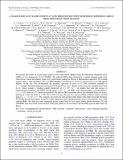A SEARCH FOR FAST RADIO BURSTS AT LOW FREQUENCIES WITH MURCHISON WIDEFIELD ARRAY HIGH TIME RESOLUTION IMAGING
Author(s)
Tingay, S. J.; Trott, C. M.; Wayth, R. B.; Bernardi, G.; Bowman, J. D.; Briggs, F.; Deshpande, A. A.; Gaensler, B. M.; Greenhill, L. J.; Hancock, P. J.; Hazelton, B. J.; Johnston-Hollitt, M.; Kaplan, D. L.; Mitchell, Daniel A.; Morales, Miguel F.; Murphy, T.; Oberoi, Divya; Prabu, T.; Shankar, N. Udaya; Srivani, K. S.; Subrahmanyan, R.; Webster, R. L.; Williams, A.; Lonsdale, Colin John; McWhirter, Stephen R.; Williams, Christopher Leigh; Feng, Lu; Cappallo, Roger J; Morgan, Edward H; ... Show more Show less
DownloadTingay-2015-A SEARCH for FAST RA.pdf (1.291Mb)
PUBLISHER_POLICY
Publisher Policy
Article is made available in accordance with the publisher's policy and may be subject to US copyright law. Please refer to the publisher's site for terms of use.
Terms of use
Metadata
Show full item recordAbstract
We present the results of a pilot study search for fast radio bursts (FRBs) using the Murchison Widefield Array (MWA) at low frequencies (139–170 MHz). We utilized MWA data obtained in a routine imaging mode from observations where the primary target was a field being studied for Epoch of Reionization detection. We formed images with 2 s time resolution and 1.28 MHz frequency resolution for 10.5 hr of observations, over 400 square degrees of the sky. We de-dispersed the dynamic spectrum in each of 372,100 resolution elements of 2 × 2 arcmin[superscript 2], between dispersion measures of 170 and 675 pc cm[superscript −3]. Based on the event rate calculations in Trott et al., which assume a standard candle luminosity of 8 × 10[superscript 37] Js[superscript −1], we predict that with this choice of observational parameters, the MWA should detect (~10, ~2, ~0) FRBs with spectral indices corresponding to (−2, −1, 0), based on a 7σ detection threshold. We find no FRB candidates above this threshold from our search, placing an event rate limit of <700 above 700 Jy ms per day per sky and providing evidence against spectral indices α < -1.2 (S ∞ μ[superscript a]). We compare our event rate and spectral index limits with others from the literature. We briefly discuss these limits in light of recent suggestions that supergiant pulses from young neutron stars could explain FRBs. We find that such supergiant pulses would have to have much flatter spectra between 150 and 1400 MHz than have been observed from Crab giant pulses to be consistent with the FRB spectral index limit we derive.
Date issued
2015-12Department
Haystack Observatory; MIT Kavli Institute for Astrophysics and Space ResearchJournal
The Astronomical Journal
Publisher
IOP Publishing
Citation
Tingay, S. J., C. M. Trott, R. B. Wayth, G. Bernardi, J. D. Bowman, F. Briggs, R. J. Cappallo, et al. “A SEARCH FOR FAST RADIO BURSTS AT LOW FREQUENCIES WITH MURCHISON WIDEFIELD ARRAY HIGH TIME RESOLUTION IMAGING.” The Astronomical Journal 150, no. 6 (December 10, 2015): 199. © 2015 The American Astronomical Society
Version: Final published version
ISSN
1538-3881
0004-6256